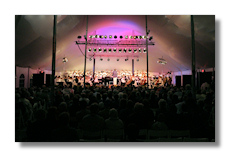
Why So Serious?
How the classical concert took shape.
By Alex Ross
The modern classical-music performance, as audiences have come to know it and sometimes to love it, adheres to a fairly rigid format. The music usually begins a few minutes after eight, listeners having taken their seats beforehand to peruse program notes or chat with neighbors. The evening falls into two halves, each lasting around forty-five or fifty minutes. An orchestral concert often proceeds from overture or short tone poem to solo concerto, and then to a symphony or some other major statement; a solo recital builds up to a big sonata or a virtuoso showpiece. The audience is expected to remain quiet for the duration of each work, and those who applaud between movements may face embarrassment. Around ten o'clock, the audience claps for two or three minutes, the performers bow two or three times, and all go home. Opera has a slightly looser code – the length of the evening depends on the composer's whims, and the audience makes its feelings known with sporadic applause and very occasional boos – but there, too, an atmosphere of high seriousness prevails.
Read more about this at the New Yorker website:
http://www.newyorker.com/arts/critics/musical/2008/09/08/080908crmu_music_ross














